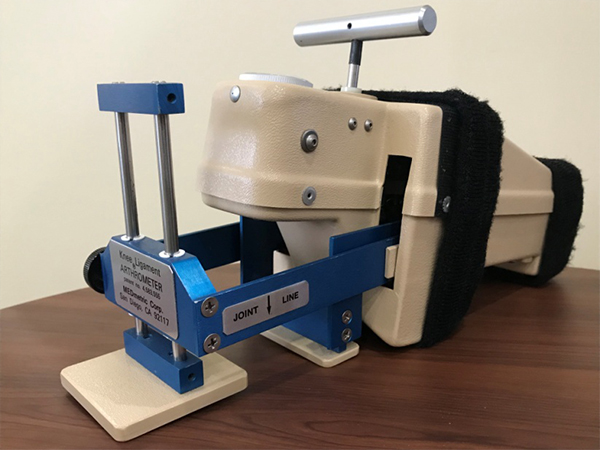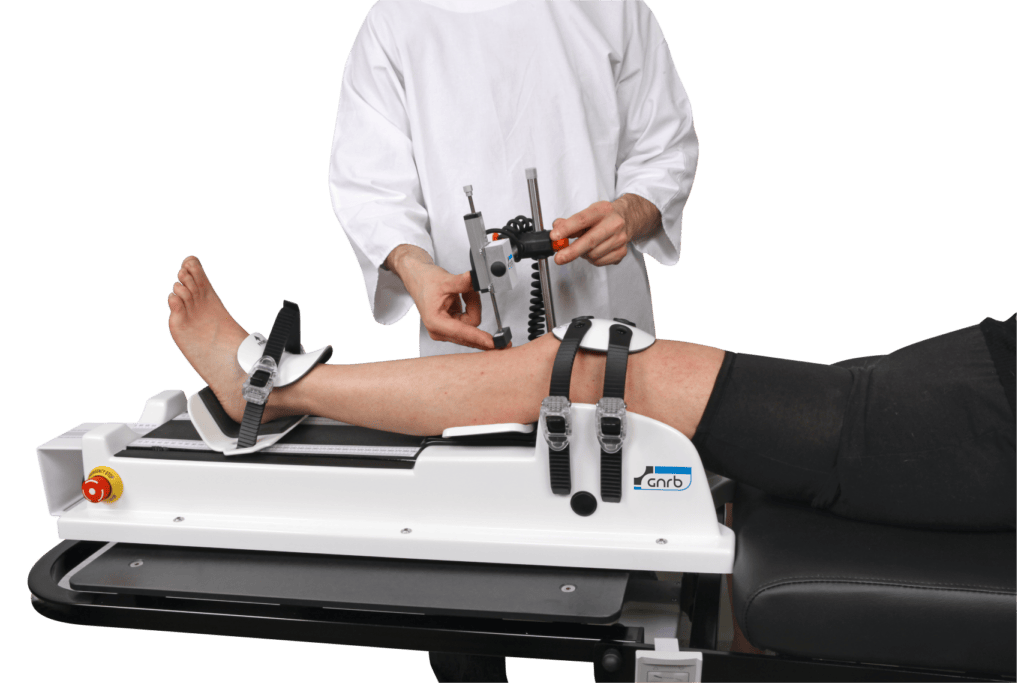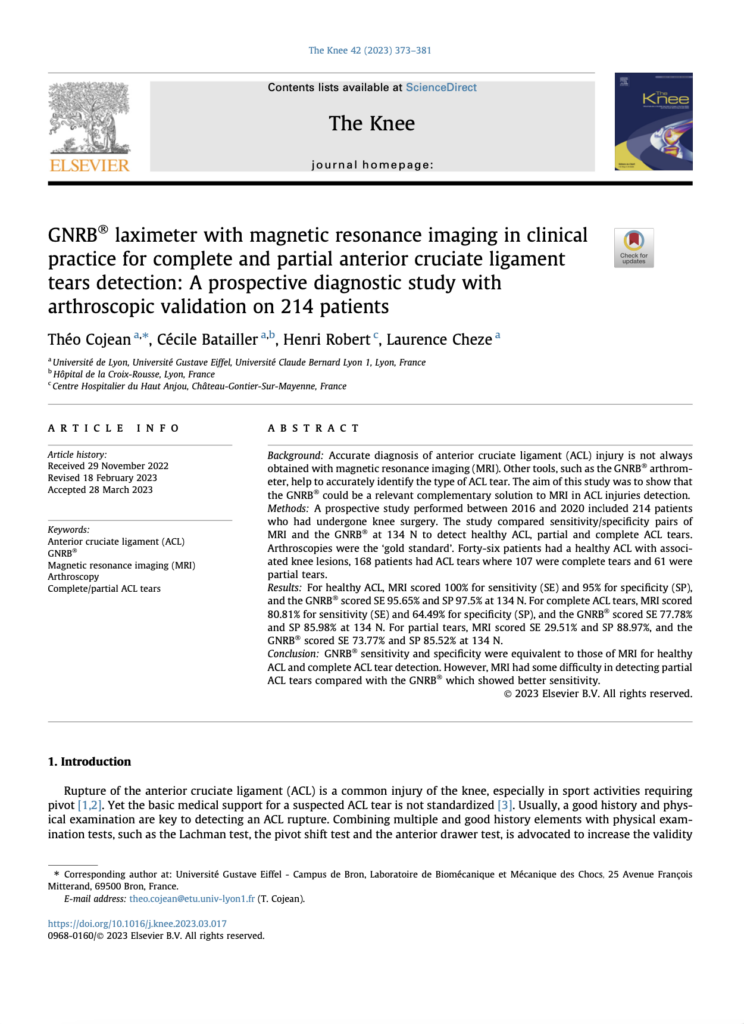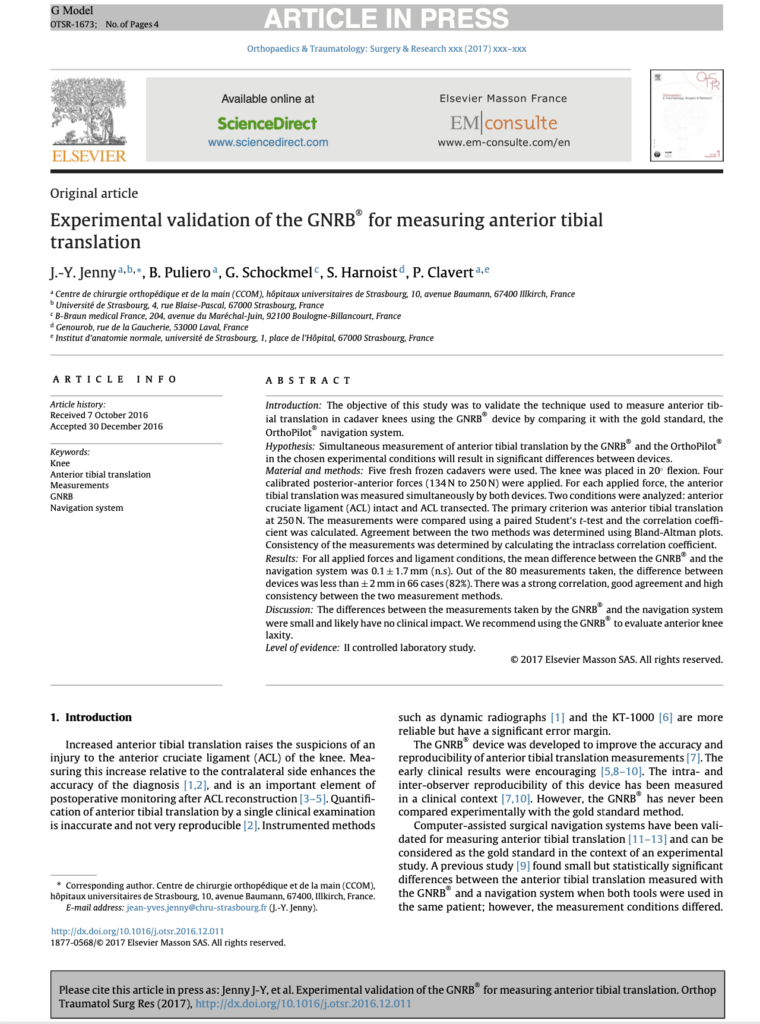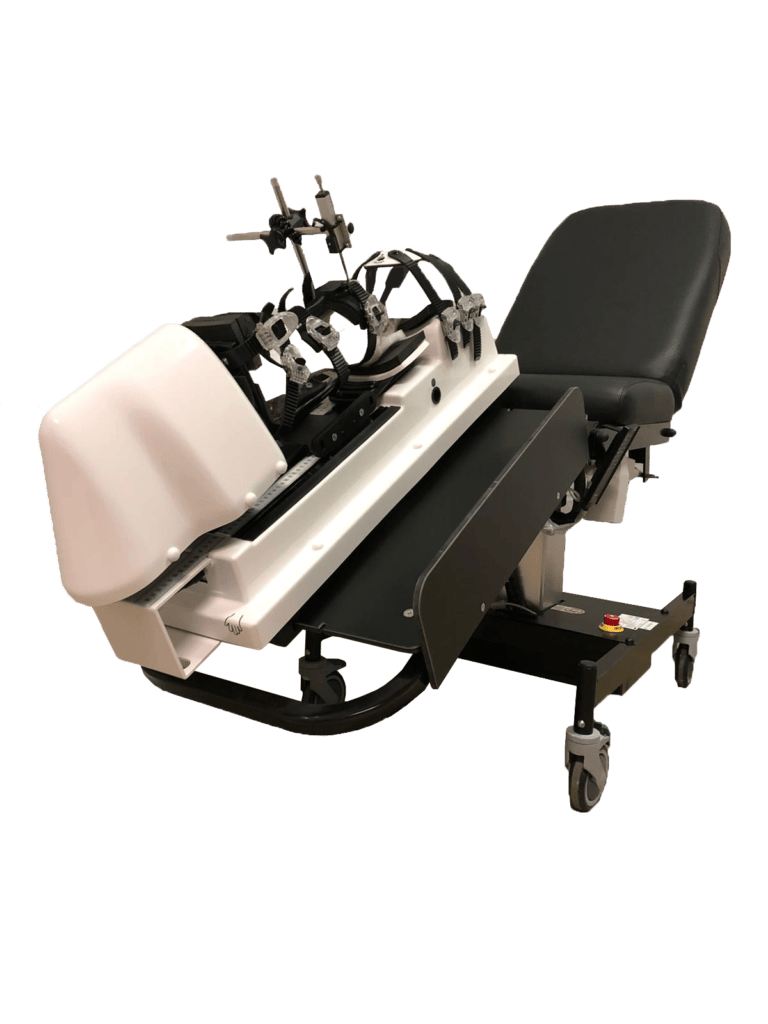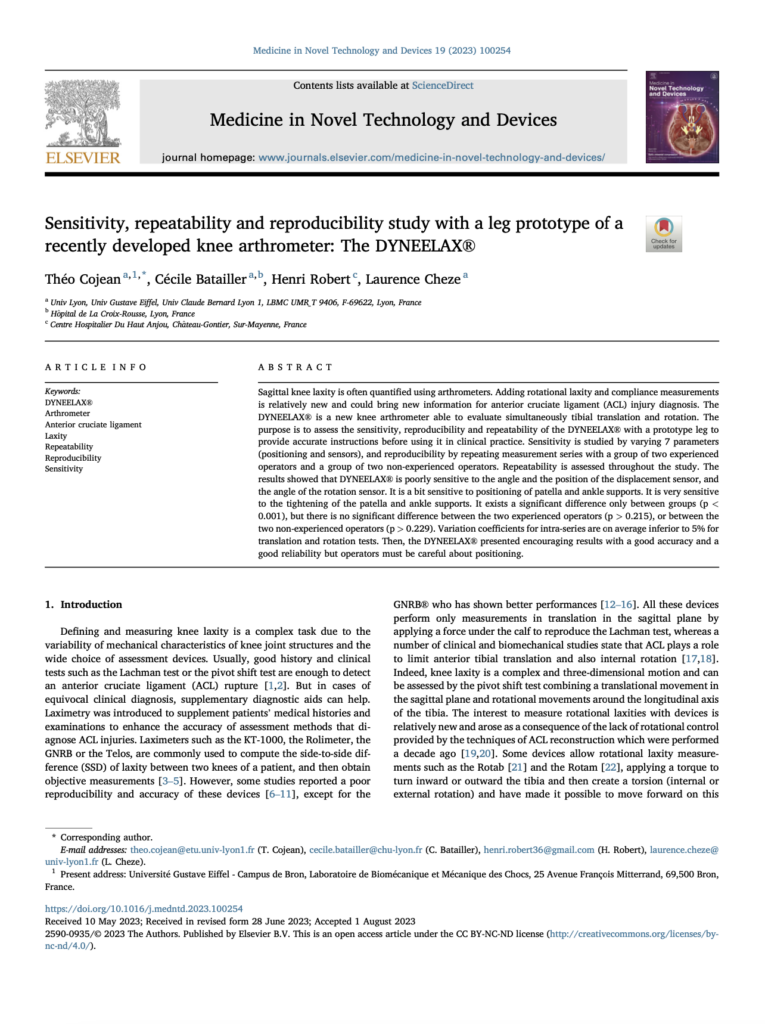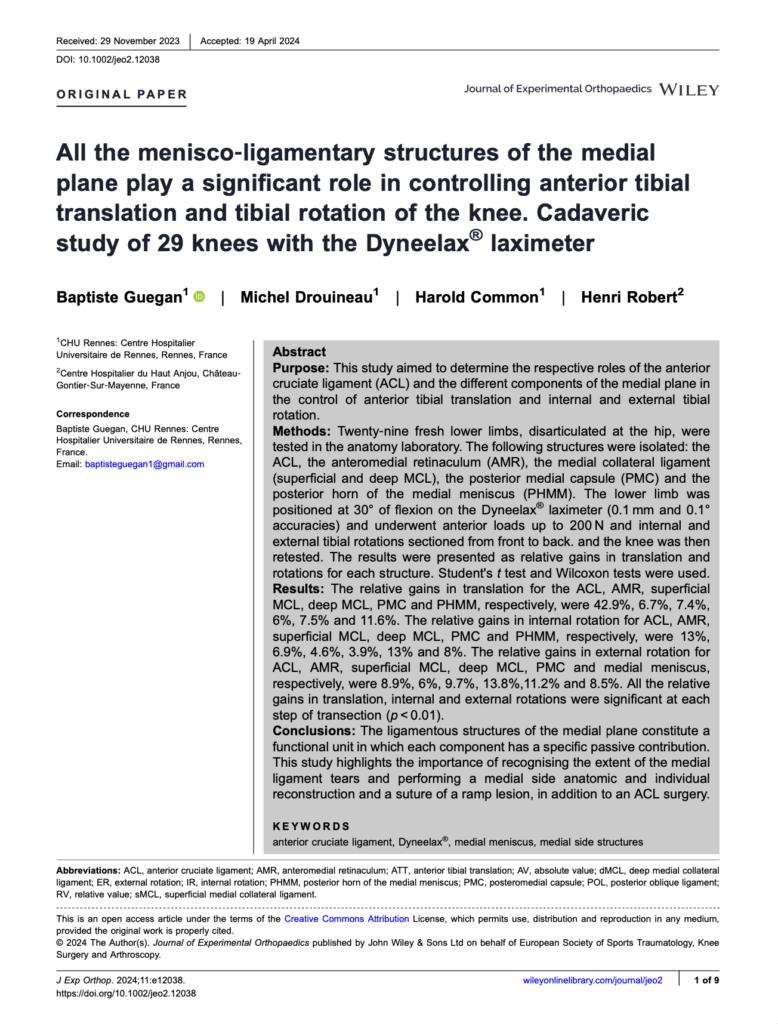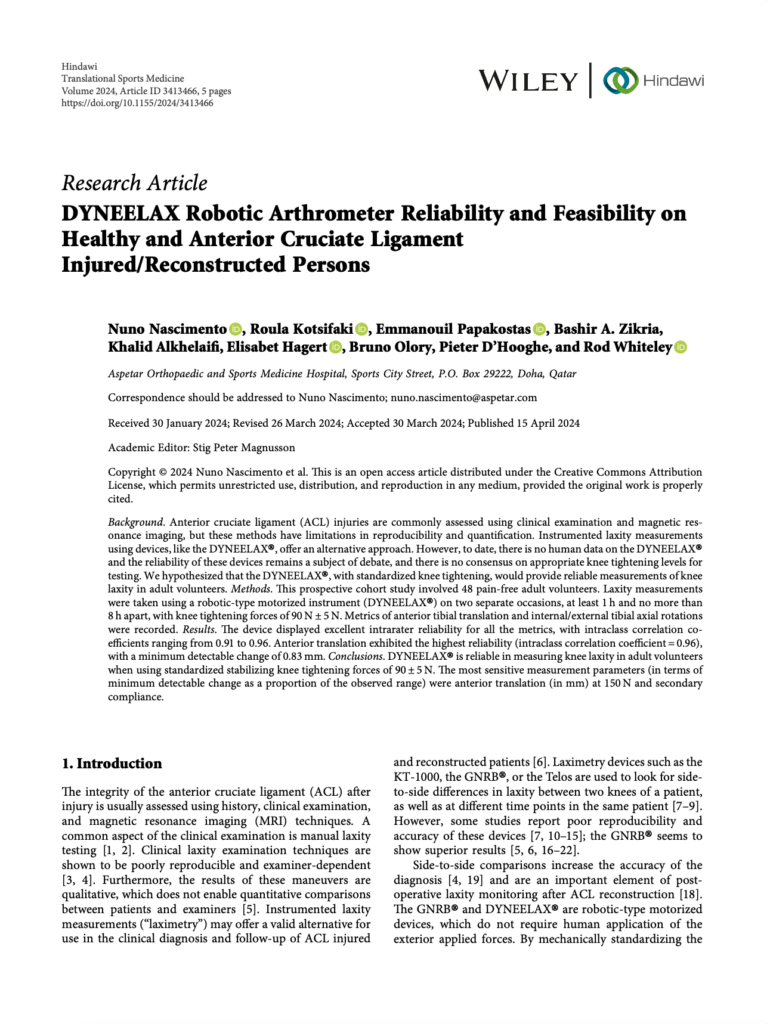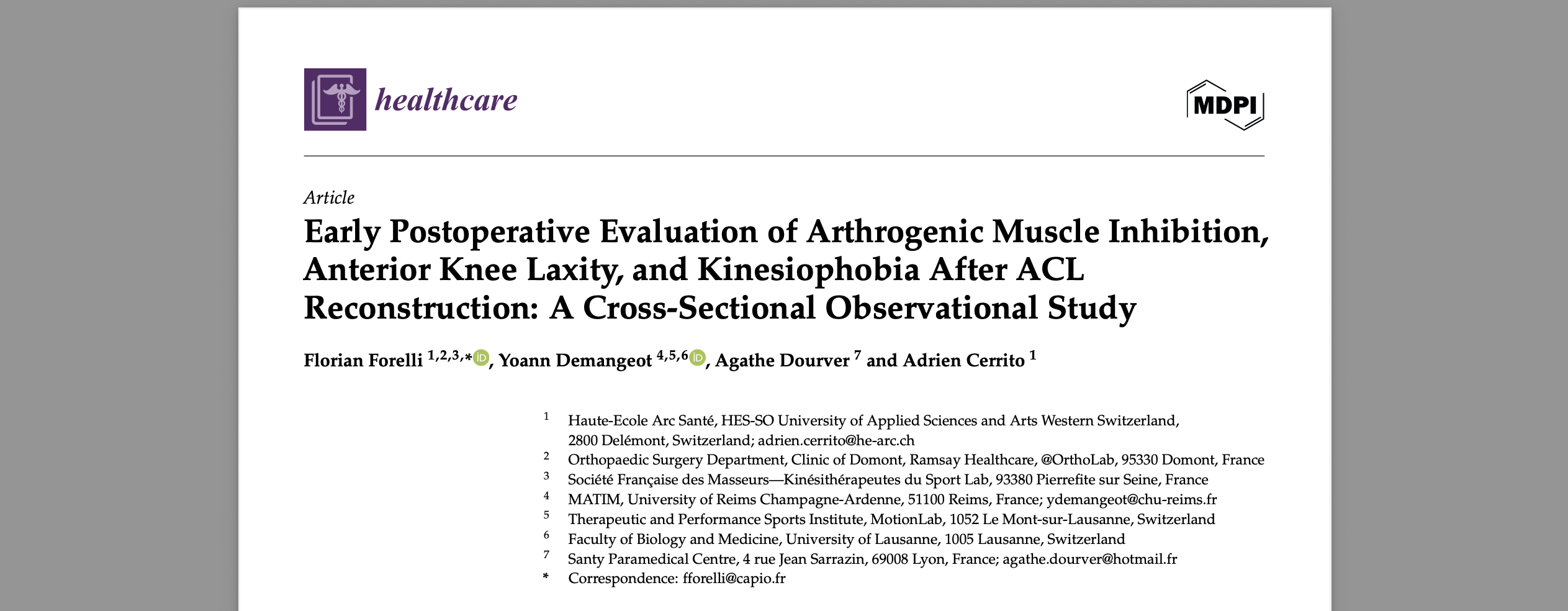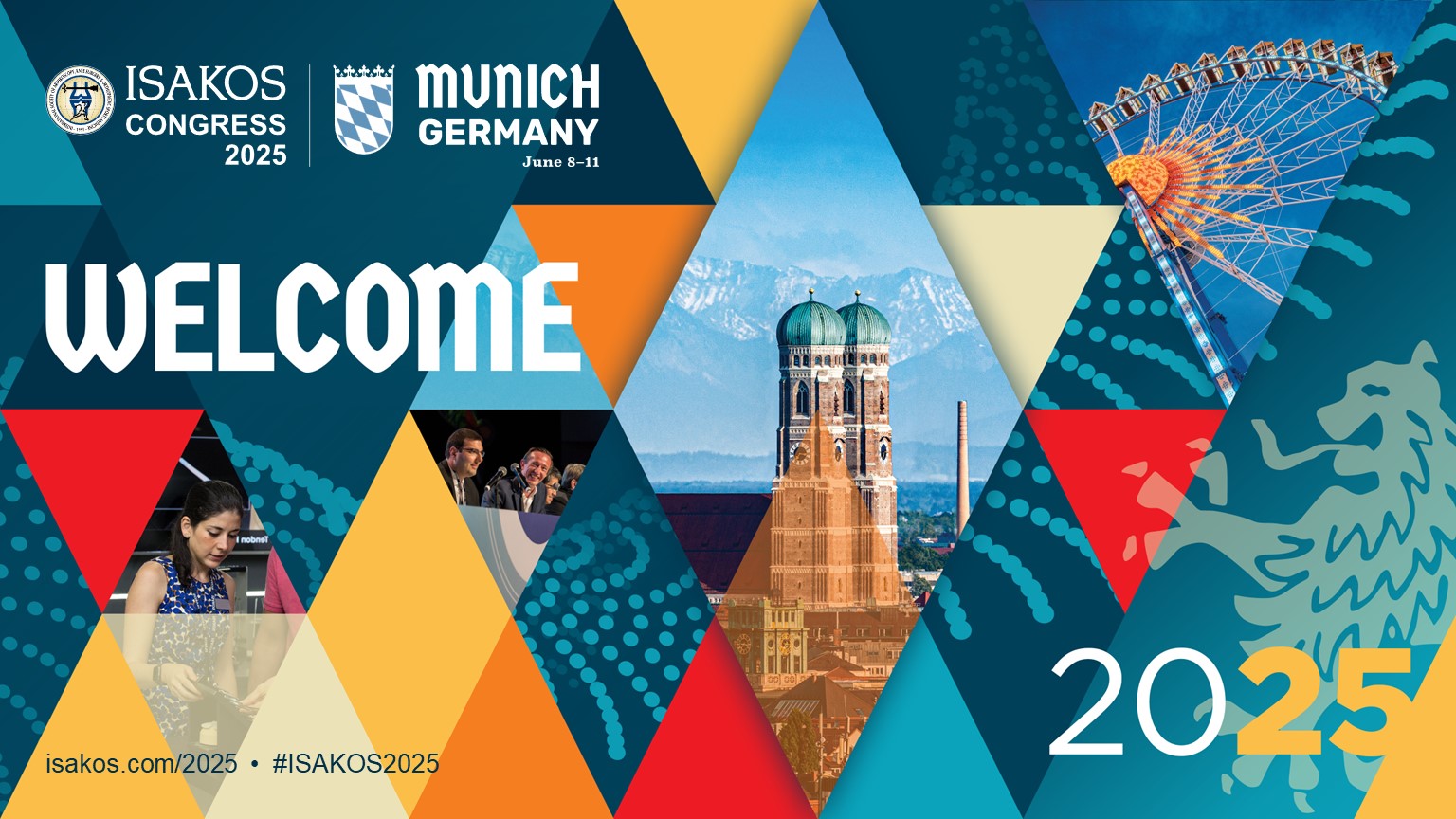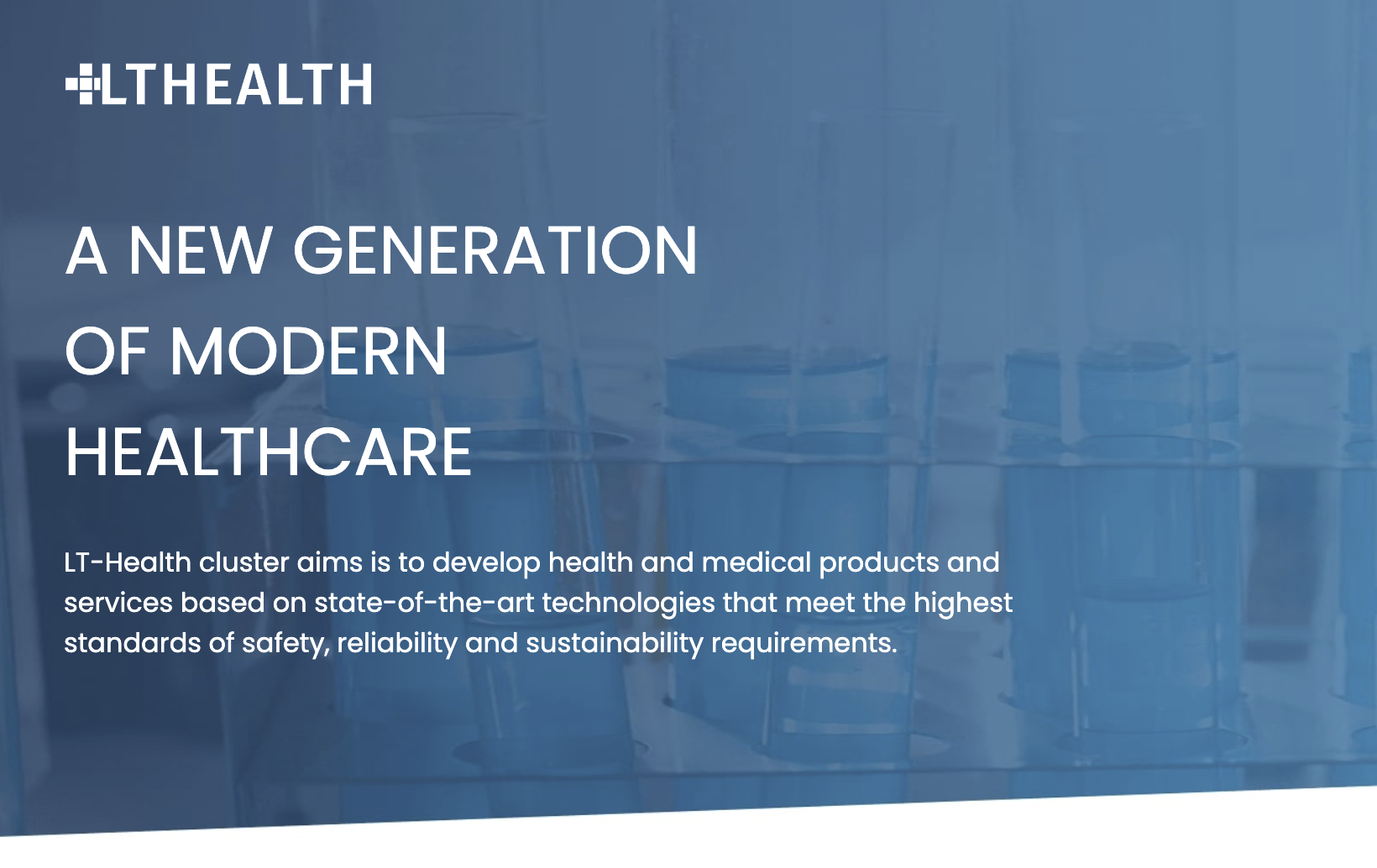Anterior Cruciate Ligament (ACL) injuries are among the most common and debilitating injuries affecting athletes and active individuals. Accurate and timely diagnosis is crucial for effective treatment and rehabilitation. Traditional diagnostic methods, such as clinical examinations and magnetic resonance imaging (MRI), have their limitations in terms of objectivity and reproducibility. This is where arthrometers come into play, offering a more precise and objective assessment of knee joint laxity and ACL integrity. In recent years, the development of robotic arthrometers, such as GNRB and Dyneelax, has revolutionized the way clinicians diagnose and monitor ACL injuries, providing enhanced accuracy and reliability in measurements. This article explores the advanced capabilities of these robotic arthrometers and their significant role in ACL injury diagnosis.
Understanding ACL Injuries

The Anterior Cruciate Ligament (ACL) is a critical ligament located within the knee joint, connecting the femur to the tibia. It plays a vital role in stabilizing the knee by preventing excessive forward movement of the tibia and controlling rotational forces. ACL injuries often occur during activities that involve sudden stops, changes in direction, or awkward landings, commonly affecting athletes in sports such as soccer, basketball, and skiing.
Common symptoms of an ACL injury include a popping sensation at the time of injury, severe pain, rapid swelling, and a feeling of instability or “giving way” in the knee. Diagnosing ACL injuries traditionally involves a combination of clinical examinations, such as the Lachman test and anterior drawer test, alongside imaging techniques like Magnetic Resonance Imaging (MRI). While these methods provide valuable information, they can sometimes lack the objectivity and reproducibility needed for precise assessment, leading to the development of more advanced diagnostic tools like robotic/dynamic arthrometers.
The Evolution of Arthrometry in ACL Injury Diagnosis
Arthrometry has a rich history in the realm of ACL injury diagnosis, evolving significantly over the decades. Initially, simple manual techniques were employed to gauge knee laxity, but these methods often lacked precision and consistency. The advent of manual arthrometers, such as the KT-1000 and KT-2000, marked a pivotal shift by providing more objective measurements of anterior tibial translation, albeit still dependent on examiner technique and subject positioning.
The key advantages of using arthrometers over traditional diagnostic methods include their ability to deliver quantitative data, improved objectivity, and the elimination of radiation exposure compared to imaging techniques. These devices have enhanced the accuracy and reliability of ACL injury assessments, facilitating better clinical decision-making.
The latest advancement in this field is the development of robotic/dynamic arthrometers like GNRB and Dyneelax. These tools offer automated, standardized testing procedures, significantly reducing examiner variability and increasing measurement precision. Robotic arthrometers represent the cutting edge of ACL diagnosis, ensuring higher reproducibility and accuracy in clinical practice.
GNRB Robotic Arthrometer
The GNRB® Robotic Arthrometer is an advanced diagnostic tool designed to measure anterior tibial translation with high precision, thereby evaluating the integrity of the Anterior Cruciate Ligament (ACL). Developed to overcome the limitations of traditional arthrometers, the GNRB device offers automated and standardized measurements, ensuring consistency and reliability in clinical assessments.
Mechanism of Action
The GNRB® operates by applying controlled anterior forces to the tibia while the patient’s knee is stabilized at 20 degrees of flexion. This position mimics the Lachman test, a standard clinical maneuver for detecting ACL injuries. The device precisely measures the displacement of the tibia relative to the femur, providing quantitative data on knee laxity.
Key Features and Technological Advancements
Key features of the GNRB include its automated force application, integrated sensors, and real-time data acquisition. These technological advancements minimize examiner dependency and reduce variability in measurements. The device’s ability to control and standardize testing conditions enhances its accuracy and reliability.
Clinical Studies and Validation
Several studies have validated the effectiveness of the GNRB arthrometer:
- Smith 2022 (1): This study highlighted the reliability of the GNRB in measuring ACL stiffness and laxity, showing intraclass correlation coefficients (ICC) ranging from 0.72 to 0.83 .
- Cojean 2023 (2): MRI vs GNRB: Demonstrated that the GNRB provides comparable accuracy to MRI in assessing ACL injuries, reinforcing its clinical utility .
- Magdic 2023 (3): Confirmed the intra-rater reliability of the GNRB for measuring knee anterior laxity in healthy subjects, with ICC values indicating good reliability at various force levels .
- Jenny 2017 (4): Validated the GNRB’s ability to measure anterior tibial translation accurately, supporting its use in both research and clinical practice .
- and many more…
Application in Clinical Settings
In clinical settings, the GNRB® is used to objectively assess ACL integrity. The procedure involves positioning the patient’s leg on the device, aligning the knee joint with the sensors, and applying specified forces. The device records the anterior tibial displacement, which is then analyzed to determine the degree of knee laxity. The GNRB is superior to MRI in analyzing partial ruptures, making it invaluable for precise surgical planning. Additionally, the GNRB® is also utilized in rehabilitation settings to monitor the graft, ensuring proper healing and guiding the rehabilitation process. These comprehensive capabilities make the GNRB an essential tool in both the diagnosis and post-surgical management of ACL injuries.
Procedure for Using GNRB
- Position the patient: The patient lies supine with the knee flexed at 20 degrees.
- Stabilize the knee: The device’s patellar pad stabilizes the patella.
- Apply force: The GNRB applies incremental forces to the tibia.
- Record displacement: Sensors measure the tibial displacement.
- Analyze data: The results are displayed and analyzed for clinical interpretation.
Interpretation of Results
The data obtained from the GNRB provides a quantitative measure of anterior tibial translation. Increased displacement indicates higher knee laxity, suggesting potential ACL compromise. These results assist clinicians in diagnosing ACL injuries, planning treatment strategies, and monitoring rehabilitation progress.
In summary, the GNRB Robotic Arthrometer represents a significant advancement in the objective assessment of ACL injuries, providing reliable and accurate measurements essential for effective clinical management.
Dyneelax Robotic Arthrometer
The DYNEELAX® Robotic/dynamic Arthrometer is a state-of-the-art diagnostic tool designed to assess anterior tibial translation and rotational laxity with high precision. Developed to enhance the accuracy and reproducibility of knee joint assessments, the Dyneelax device offers advanced capabilities for evaluating the Anterior Cruciate Ligament (ACL) integrity, surpassing many traditional diagnostic methods.
Mechanism of Action
The Dyneelax operates by applying controlled forces to the tibia and simultaneously measuring both anterior displacement and rotational movements. This dual capability allows for a comprehensive assessment of knee laxity, capturing complex biomechanical behaviors that are critical for diagnosing ACL injuries.
Key Features and Technological Advancements
Key features of the DYNEELAX® include its robotic/dynamic force application, integrated multi-directional sensors, and real-time data visualization. The device is equipped with sophisticated software that standardizes testing procedures and provides detailed force-displacement and rotation curves, enhancing the objectivity and precision of measurements. The inclusion of sensors to monitor internal and external rotations sets Dyneelax apart from other arthrometers.
Clinical Studies and Validation
Several studies have validated the effectiveness of the Dyneelax arthrometer:
- Cojean 2023 (5): Demonstrated high sensitivity and reproducibility of the Dyneelax device, highlighting its ability to detect subtle changes in knee laxity with excellent repeatability.
- Guegan 2024 (6): Explored the role of various menisco-ligamentary structures in controlling anterior tibial translation and tibial rotation, affirming the device’s utility in complex biomechanical assessments.
- Nascimento 2024 (7): Confirmed the reliability and feasibility of the Dyneelax for both healthy and ACL-injured/reconstructed subjects, with intraclass correlation coefficients (ICC) ranging from 0.91 to 0.96, indicating excellent reliability.
Application in Clinical Settings
In clinical settings, the Dyneelax is used to perform detailed assessments of knee laxity by measuring both anterior tibial translation and rotational movements. The procedure involves positioning the patient’s leg on the device, ensuring proper alignment, and applying controlled forces. The device records both anterior tibial displacement and rotational movements, which are then analyzed to provide a comprehensive picture of knee stability. The combination of rotation and translation measurements considerably enhances the diagnosis of the ACL and surrounding structures, providing a more thorough understanding of knee mechanics.
The dual capability of the Dyneelax offers superior diagnostic precision, allowing for more detailed surgical planning. This advanced diagnostic information ensures that surgical interventions are tailored to the specific needs of the patient, improving outcomes. Furthermore, the Dyneelax is also employed in rehabilitation settings to monitor the healing process of the graft and other knee structures. This comprehensive monitoring capability ensures that the rehabilitation process is optimized, guiding adjustments in therapy to promote better recovery.
Overall, the Dyneelax Robotic Arthrometer is an invaluable tool in modern orthopedic practice, offering enhanced diagnostic capabilities and precise monitoring that support both pre-surgical planning and post-surgical rehabilitation.
Procedure for Using Dyneelax
- Position the patient: The patient sits with the trunk inclined at 30 degrees and the knee flexed at 20 degrees.
- Stabilize the knee: The knee is positioned in the device with the patella stabilized.
- Apply forces: The Dyneelax applies incremental anterior and rotational forces to the tibia.
- Record measurements: Sensors capture tibial displacement and rotation.
- Analyze data: The results are displayed as force-displacement and rotation curves for interpretation.
Interpretation of Results
The data obtained from the Dyneelax provides a quantitative measure of both anterior tibial translation and rotational laxity. Increased displacement or translation/rotation indicates higher knee laxity, suggesting potential ACL compromise. These comprehensive results assist clinicians in diagnosing ACL injuries, planning surgery & treatment strategies, and monitoring rehabilitation progress.
The Dyneelax Robotic Arthrometer represents a significant advancement in the objective assessment of ACL injuries, providing reliable and detailed measurements essential for effective clinical management. Its dual capability to measure both translational and rotational laxity offers a more holistic view of knee stability, making it an invaluable tool in modern orthopedic practice.
Comparing GNRB and Dyneelax
Both the GNRB and Dyneelax robotic arthrometers provide high levels of accuracy and reliability in assessing ACL injuries. However, the Dyneelax is superior due to its integration of rotational and translational measurements, offering more precise diagnostics of the ACL and surrounding structures. While the GNRB laid the foundation with its advanced technology, the Dyneelax builds on this, incorporating additional features for comprehensive evaluations. Both devices are easy to use, but the Dyneelax’s enhanced capabilities make it more effective in clinical applications, particularly for surgical planning and rehabilitation monitoring.
Benefits of Using Robotic Arthrometers for ACL Diagnosis
Robotic arthrometers, such as the GNRB and Dyneelax, offer significant benefits for ACL diagnosis:
- Diagnosis of the ACL: These devices provide enhanced accuracy and reliability, being more precise than MRI for diagnosing partial ruptures.
- Surgical Planning: The dynamic aspect of testing with robotic arthrometers complements the static assessments done with MRI. Translation measures the ACL directly, while rotation captures subtleties that could be missed in MRI, facilitating precise and effective surgical planning.
- Rehabilitation: Robotic arthrometers enable personalized rehabilitation by continuously monitoring the graft, ensuring proper healing and guiding adjustments in therapy.
These advanced tools ensure consistent and objective results, minimizing examiner dependency and supporting better diagnostic and treatment strategies in modern orthopedic practice.
Conclusion
Accurate ACL diagnosis is crucial for effective treatment and rehabilitation. Advanced robotic arthrometers like the GNRB and Dyneelax play a vital role in modern clinical practice, offering precise and reliable assessments. Future research and technological advancements will continue to enhance their diagnostic capabilities and clinical applications.
Medical References
- Smith K, Miller N, Laslovich S. (2022). The Reliability of the GNRB® Knee Arthrometer in Measuring ACL Stiffness and Laxity: Implications for Clinical Use and Clinical Trial Design. Int J Sports Phys Ther, 17(6), 1016-1025. DOI: 10.26603/001c.38252
- Cojean T, Batailler C, Robert H, Cheze L. (2023). GNRB® laximeter with magnetic resonance imaging in clinical practice for complete and partial anterior cruciate ligament tears detection: A prospective diagnostic study with arthroscopic validation on 214 patients. Knee, 42, 373-381. DOI: 10.1016/j.knee.2023.03.017
- Magdić M, Gošnak Dahmane R, Vauhnik R. (2023). Intra-rater reliability of the knee arthrometer GNRB® for measuring knee anterior laxity in healthy active subjects. Journal of Orthopaedics. DOI: 10.1016/j.jor.2023.03.016
- Jenny J-Y, Puliero B, Schockmel G, Harnoist S, Clavert P. (2017). Experimental validation of the GNRB® for measuring anterior tibial translation. Orthopaedics & Traumatology: Surgery & Research. Received: 7 October 2016, Accepted: 30 December 2016 DOI: 10.1016/j.otsr.2016.12.011
- Cojean, T., Batailler, C., Robert, H., Cheze, L. (2023). Sensitivity repeatability and reproducibility study with a leg prototype of a recently developed knee arthrometer: The DYNEELAX®. Medicine in Novel Technology and Devices, 19, 100254. DOI: 10.1016/j.medntd.2023.100254
- Guegan, B., Drouineau, M., Common, H., & Robert, H. (2024). All the menisco-ligamentary structures of the medial plane play a significant role in controlling anterior tibial translation and tibial rotation of the knee: Cadaveric study of 29 knees with the Dyneelax® laximeter. Journal of Experimental Orthopaedics, 11, e12038. DOI: 10.1002/jeo2.12038
- Nascimento, N., Kotsifaki, R., Papakostas, E., Zikria, B. A., Alkhelaif, K., Hagert, E., Olory, B., D’Hooghe, P., & Whiteley, R. (2024). DYNEELAX Robotic Arthrometer Reliability and Feasibility on Healthy and Anterior Cruciate Ligament Injured/Reconstructed Persons. Translational Sports Medicine, 2024(1), 1-5. DOI: 10.1155/2024/3413466

